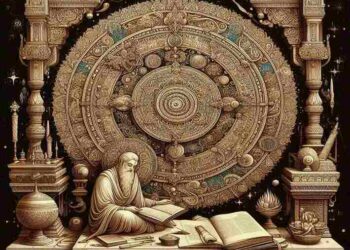Table of Contents
ToggleIntroduction
Sudraka Mrcchakatika Summary ,Themes A poet-dramatist whose precise historical identification is still up for discussion, Sudraka is the author of the classic Sanskrit play Mṛcchakatika (The Little Clay Cart).
One of the most important pieces of Sanskrit drama, the play is renowned for its depiction of social stratification, political intrigue, love, and the complex interplay of human emotions. With the lives of monarchs, merchants, courtesans, and commoners blending into a rich and intricate story, Mṛcchakatika depicts a realistic social panorama of ancient Indian civilization.
The main plot of the play is on the intense romance between the nobleman Charudatta and the courtesan Vasantika, which is framed by political intrigue, class conflict, and selflessness. Mṛcchakatika, the title of the play, means “The Little Clay Cart,” and it represents the fleeting and delicate nature of material wealth, love, and human existence.
Summary of Mṛcchakatika
Mṛcchakatika is a play with ten acts that presents a vivid portrayal of the society in ancient India, combining elements of romance, social commentary, and political intrigue. It is set in the city of Ujjayini, a prosperous kingdom ruled by the king Shaktik. The drama touches on themes such as love, betrayal, corruption, and the struggle between good and evil.
Act 1: The Plot Unfolds
The play opens with a focus on Charudatta, a virtuous Brahmin merchant, who has fallen on hard times due to his personal generosity. Once a wealthy man, he now struggles to support his family, yet his moral character remains unwavering. Despite his poverty, Charudatta’s inherent goodness attracts the affection of others, especially the beautiful courtesan Vasantika.
The political backdrop of the play is set when Vasavadatta, the wife of King Shaktik’s brother Dhananjoy, is kidnapped by a man named Samsthanaka, who is a powerful and malicious nobleman. Samsthanaka’s desire for Vasantika leads him to further plot evil deeds.
Act 2: The Courtesan’s Dilemma
The second act introduces Vasantika, who is a courtesan by profession but also a woman of deep emotional intelligence and kindness. Although she is used to a life of luxury, Vasantika’s heart is moved by the nobility of Charudatta, whom she sees as a person of integrity and righteousness. As their relationship blossoms, Vasantika becomes the central female character around whom much of the emotional and social drama revolves.
However, the presence of Samsthanaka, who is attracted to Vasantika, becomes a significant source of tension. He demands her love, and when she rejects his advances, he uses his power to manipulate and scheme, further deepening the dramatic tension.
Act 3: The Clay Cart
In a striking metaphorical moment, Charudatta is seen riding a small clay cart (the Mṛcchakatika), which symbolizes the precariousness of his situation. Though his world is built on goodness and virtue, he is forced to navigate a society fraught with corruption and violence. The little clay cart that he rides represents not just his personal circumstances but also the fragility of life itself. The clay cart’s inability to survive harsh conditions mirrors Charudatta’s precarious position in a society full of political and social turmoil.
Act 4: The Theft and Conflict
The political intrigue deepens when Charudatta is wrongly accused of theft. The court drama that ensues highlights the systemic corruption within the judicial and political system. Despite his integrity, Charudatta is thrown into prison, and Vasantika, who deeply cares for him, struggles to navigate the powerful forces arrayed against them.
In this act, we see the collision between different social classes—noblemen, commoners, merchants, and courtesans—and the oppressive power wielded by figures like Samsthanaka.
Act 5: Reversal of Fortunes
As the play progresses, Charudatta’s circumstances change drastically. Through various twists and turns, the play takes on a more comedic tone, focusing on the dramatic reversal of Charudatta’s fortunes. Charudatta’s eventual release from prison and his ability to outwit his enemies mark a turning point. However, the play remains grounded in the realism of human emotions—love, ambition, and moral dilemmas.
Act 6: The Conspiracy Unravels
The plot deepens when Charudatta’s enemies—particularly Samsthanaka—continue their manipulative schemes. Samsthanaka’s desperate desire to take control of Vasantika’s affections and to eliminate his rivals creates a tense atmosphere where each character must confront their personal moral dilemmas.
The drama comes to a climax when Charudatta’s rival, Samsthanaka, is exposed as a corrupt and immoral person. This act marks the unmasking of true virtue, where Charudatta’s honesty and integrity are highlighted against the backdrop of political deceit.
Act 7-10: Resolution and Conclusion
The final acts of the play provide a resolution to the love story and the political intrigue. The play concludes with the reunion of Charudatta and Vasantika. Despite all the turmoil, misunderstandings, and manipulations, their love triumphs. The play ends on a note of restoration and moral victory, with the villain, Samsthanaka, receiving his just deserts.

Themes in Mṛcchakatika
The play Mṛcchakatika is rich with multiple thematic layers that explore human nature, social dynamics, and moral conflicts. Here are some of the key themes:
1. Love and Virtue
At its heart, Mṛcchakatika is a love story—one between Charudatta and Vasantika. Despite their difference in social status—Charudatta being a Brahmin merchant and Vasantika a courtesan—their love remains pure and selfless. Charudatta’s virtue, kindness, and moral integrity set him apart from other men, while Vasantika’s deep emotional intelligence and loyalty to Charudatta make her an extraordinary woman. Their love defies the conventions of their society and remains a powerful symbol of selfless devotion and virtue.
2. Class and Social Structure
One of the play’s central concerns is the rigidity of social structures. Charudatta’s fall from wealth and power illustrates the fragility of status in ancient Indian society, while Vasantika’s status as a courtesan highlights the deep divides between different social classes. The characters’ struggles within these societal structures expose the flaws and injustices of a system that places value on birth rather than virtue. Sudraka critiques the inflexible caste system and demonstrates that personal virtue often transcends social position.
3. Political Corruption and Moral Struggles
The play is also a critique of political corruption. The character of Samsthanaka, who embodies greed and manipulation, represents the darker side of power and politics. He is willing to sacrifice morals for personal gain, and his actions are a reflection of the corrupt power structures in place. Through Samsthanaka, Sudraka critiques the role of power in distorting justice and the moral order.
4. Integrity and Sacrifice
Charudatta, the protagonist, embodies the ideals of integrity and sacrifice. He is depicted as someone who values ethics over material wealth, and his selflessness is central to the play’s moral structure. In contrast, the play also shows characters who are willing to compromise their moral values for personal gain—particularly Samsthanaka, who is willing to exploit others to achieve his desires.
5. Fate and Fortune
The theme of fate and fortune runs throughout the play, as characters experience a series of highs and lows. The play underscores the transitory nature of life, where individuals rise and fall based on circumstances beyond their control. Charudatta’s initial wealth and subsequent downfall demonstrate how easily fortune can shift, yet his resilience and goodness remain intact, showing that moral fortitude is more enduring than material wealth.

Conclusion
Mṛcchakatika is a timeless masterpiece that skillfully combines moral quandaries, political intrigue, and romantic passion into an engaging story. A potent commentary on the intricacies of human nature and society is offered by Sudraka’s depiction of morally upright people like Charudatta and Vasantika in contrast to corrupt and power-hungry individuals like Samsthanaka.
In addition to being a classic of Sanskrit literature, the drama provides insightful analysis of the human condition through its complex examination of love, integrity, and societal institutions. Mṛcchakatika continues to be a timeless work of literature that audiences find compelling due to its moral precepts and emotional depth, which illuminate the never-ending conflict between justice and power, money and virtue, and good and evil.
Important Questions
1. Who is Sudraka?
Sudraka is the author of Mṛcchakatika, an ancient Indian playwright whose historical identity is uncertain. Some believe he may have been a king or a nobleman, while others consider him a court poet. He is known for his works that blend social realism with profound moral and philosophical reflections.
2. What is the significance of the title Mṛcchakatika (The Little Clay Cart)?
The title refers to the fragility of human life and material wealth. The little clay cart symbolizes how easily life and fortunes can be destroyed, yet it also serves as a metaphor for the transient nature of love and power.
3. What role does class play in the play?
Class is a central theme in Mṛcchakatika. The play portrays the gap between different social classes, particularly between the noblemen, merchants, and courtesans. It critiques the rigid caste system and illustrates how virtue can transcend social boundaries.
4. How does Mṛcchakatika critique political power?
Through the character of Samsthanaka, the play critiques the abuse of power for personal gain. Samsthanaka’s manipulations reflect the corruption within political systems, where moral integrity is often sacrificed for wealth and influence.
5. What is the moral message of the play?
The moral message of Mṛcchakatika is the triumph of virtue and selflessness over corruption and greed. Charudatta’s moral integrity and unwavering love for Vasantika, despite the social and political challenges they face, offer a message of hope and moral righteousness.
















